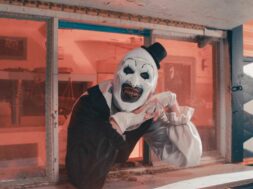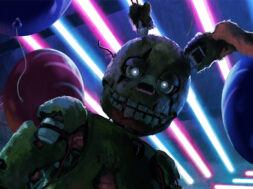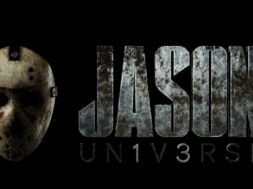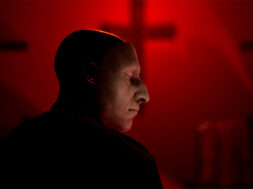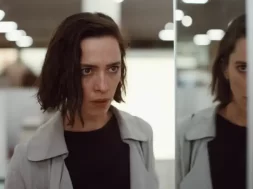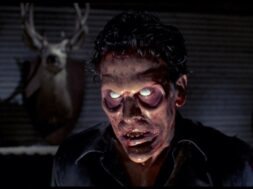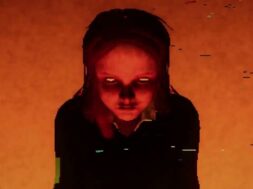Underrated ‘Paranormal Activity: The Marked Ones’ Left White Suburbia to Explore Fresh New Horrors
This year marks 11 years since the first Paranormal Activity film scared its way onto the horror scene, and there’s no denying how much it shook up the genre. Its wide-release debut brought the once-dormant found footage subgenre back into the subconscious and helped spawn a plethora of imitators that would attempt to emulate and capitalize upon its narrative success.
But as quietly disturbing and as memorable as Paranormal may have been, the diversity within its cast was far from remarkable. Since then, horror as a whole has come a long way. More filmmakers of color like Jordan Peele and Karyn Kusama are at the genre forefront– leading the charge into the next decade– and they’ve introduced fresh perspectives and characters that come from different cultures and backgrounds, adding to the brand of inclusivity we’re now seeing more of. But in 2014, the Paranormal franchise may have had a similar plan in mind when the fifth entry in the franchise came along, the underappreciated The Marked Ones— it may have just been a few years ahead of its time.
As history goes, the first Paranormal was released in 2009 and would soon become a smash hit. With the overwhelming success of the first film– and backing from multiple producers– sequels to the handheld-phenomenon were eagerly demanded. So began the tradition of releasing a new installment almost every year, satisfying the hunger that both mainstream audiences and genre fans were beginning to crave. However, by the time of the release of the fourth installment, something was starting to become very clear: these Paranormal movies were looking and feeling all the same.
Don’t believe me?
The first four films pretty much utilized the same beat-by-beat premise, following a white, upper middle-class family living in a large, suburban home. After a series of strange occurrences, the families use cameras to document what they’re experiencing. Usually the first few nights are filled with little-to-no action, as it’s used for establishing the characters (some would argue a bit poorly) and setting the tone of the film. Over time, the scares grow more and more intense until our characters are inevitably met with horrifying demises.
Enter The Marked Ones.
Released in 2014, Paranormal Activity 5 gave us something wholly unique. By inserting the sequel into a primarily Latinx community and urban backdrop, it gave us a different set of characters and opened the possibilities for something more interesting than more of the same, old group of Caucasian families getting spooked in a big house.
Marked Ones follows Jesse (Andrew Jacobs) and Hector (Jorge Diaz), two longtime best friends trying to make the most of their summer. After buying a camera with some graduation money, the pair spend their time recording each other goofing around. Soon after, Ana (Gloria Sandoval), Jesse’s creepy neighbor, is found brutally murdered in her apartment, while Oscar (Carlos Chalabi)– one of Jesse’s old classmates– is seen fleeing from her house. After the police exit the crime scene, the group of teens investigate Ana’s apartment and find all sorts of unnerving imagery and a notebook containing spells and portals to other dimensions, along with some videotapes and the like. This prompts Jesse and Hector, along with their friend Marisol (Gabrielle Walsh), to enact one of these rituals, which sets all the Activity into motion.
One night, the trio ultimately contacts a spirit through a Simon game, which Jesse’s superstitious grandmother Irma (Renée Victor) is immediately against. She warns the teens of the dangers this can bring them and insists they discard it. After being attacked by thugs, Jesse discovers that he has been given supernatural powers- including the ability to levitate, as well as telepathy- which he and Hector use for entertainment, recording the stunts and posting them online. Though one night, the two return to Ana’s apartment and find Oscar, who had apparently been staying in a hidden section of the house. Oscar warns Jesse that soon the force will want to take over his body and the only way to stop that is taking their own lives. This then leads to a pretty cool and intense scene with Hector and Jesse as they search for Oscar, who lands on a nearby car after jumping off the roof. After Oscar’s death, the three explore the hidden lair and uncover an altar for rituals and several photos of pregnant women– including Jesse’s mother who is seen with the patriarchal coven leader Lois (Hallie Foote), Katie and Kristi’s grandmother from the third installment.
Later in the film, we see Jesse’s drastic change in personality, becoming increasingly violent, not only to Marisol and Hector, but to his family as well. The situation becomes so dire that Irma visits a botánica, a store commonly known in Latinx culture for selling herbal remedies, religious charms, and spiritual cleansings. This rather minute scene is actually a great example of the attention-to-detail that Marked Ones writer/director Christopher Landon pays to the Latinx community and its heritage. Those who are Latinx and were raised in a practicing household (such as myself) know of the illustrious botánica, where parents and/or older family members would go and collect religious artifacts for the home. And this is just one of the many instances in which the film references real, tangible things in the collective unconscious of Latinx culture. In an earlier sequence, Hector jokingly references “El Cucuy,” an urban legend that is passed on to children who misbehave, comparable to that of “The Boogeyman.”
It’s these little nuances that show just how much thought went into making Marked Ones feel authentic– something that Landon and producers were persistent about when writing the screenplay. In an interview with Ryan Turek for Shock Till You Drop back in 2014, Landon mentioned a young, Latinx woman who participated in a focus group for the third Paranormal. Her devotion to the films and how she connected them to her own experience and family inspired Landon and producers to shift the franchise’s focus to something that involved a different kind of community’s perspective than had been seen prior. Spin-off The Marked Ones was born.
Additionally, although Marked Ones was indeed considered a “spin-off” from the rest of the franchise, it helped tie up a lot of loose ends within the franchise. We see the return of Ali Rey (Molly Ephraim) from Paranormal 2– the first actual mention of her or the Rey family since the beginning of the third entry. Ali clues both Hector and Marisol in on everything that’s happened and warns them of the Coven’s sinister plans. Landon wanted to make sure this entry didn’t feel so disconnected from the rest of the series, despite its deviations from the previous installments. In doing so, it oddly helped the movie feel more coherent than some of the other entries and added to the good quality of writing that’s evident in this movie.
In fact, in wanting to guarantee that this film felt connected to the rest of the franchise, it gave us one of the best, if not the best, endings in the Paranormal series, as the movie comes full-circle, taking us back to Katie’s (Katie Featherson) and Micah’s (Micah Sloat) house from the very first Paranormal film. The finale of Marked Ones gives us a different perspective to a scene from the first film, when Katie walks down the steps towards the end of the movie; however, this time, she finds a distraught and confused Hector, seeking refuge from a possessed Jesse. The possessed Katie finally acknowledges Hector and screams out for Micah, who rushes downstairs to confront Hector, who is killed in the process.
The film’s final moments show Hector bumping into a fully demonized Jesse, ending this saga. By bringing everything together, and giving the audience an unexpected twist ending, it helped inject the film (and franchise) with some freshness that it so desperately needed. And again, it isn’t just this that makes the movie feel like something more than 90 minutes of people aimlessly wandering around a large house, but also its engaging script and characters that ironically give life to a series that focuses on the dead haunting the living. Truthfully, it’s a bit surprising to think that a lot of audiences didn’t respond kindly to the film. The Marked Ones brought in $90 Million from the box office, making it the second lowest grossing entry in the franchise (The Ghost Dimension remains the lowest with $70 Million).
So how was The Marked Ones before its time?
Well, it’s the first in this series to put us somewhere other than white suburbia. We spend the movie in an apartment complex inhabited by Latinx and Hispanics alike, and our main characters are a diverse groups of teens– giving us something drastically different that we were used to from the Paranormal franchise. Few franchise films reinvent themselves so drastically, often giving us the same, worn-out shtick so they can maintain mass-appeal within the marketplace. Christopher Landon recognized this and chose to give us a Paranormal story through a different lens; one that, quite frankly, horror doesn’t always shine a proper light on. The Latinx and Hispanic communities seldom receive proper representation in horror films, and, when they do pop up, their characters feel trope-y and inaccurate; whether it’s the side character who dies before we’re halfway into the second act, i.e. Ismael (Danny Trejo) from Rob Zombie’s Halloween (2007), the scummy-creep/criminal that lingers around like Diego (Noel Gugliemi) from The Purge: Anarchy (2014), or a religious savior to an on-going evil like Shaun San Dena (Adriana Barraza) from Drag Me to Hell (2009). Oftentimes, it feels as though these characters are just slapstick plot-devices, as opposed to being actual people in a story that’s worth telling.
However, in The Marked Ones, they are the focus of the narrative. The audience develops a connection with the three friends and their kinship towards each other. Even though we’re told the trio grew up together, it’s evident in the way they talk and joke around with each other when there isn’t something horrifying going on. The idea of establishing the normalcy before the chaos in a movie is something that’s paramount so that we, the audience, can feel and understand the disruption to the status quo. Furthermore, it gives weight to the Latinx themes that are recurring throughout the film. Those who grew up in an urban, Latinx neighborhood can vouch that there is an unspoken sense of community and familiarity that everyone takes part in. Regardless of there being any relation, we care about and talk to one another as though we are family- which is what Jesse, Hector, and Marisol reflect so well. The first ten minutes of the film portray this perfectly when Jesse’s entire apartment complex throws him a graduation party. It feels as though the whole community is there, because that’s what it’s like for people who are Latinx. In a way, we all share that same euphoria, because we understand how difficult it might be for people like us to achieve such a goal. To put it simply: when one of us wins, we all win.
I do want to make it clear that I’m not saying this just because these characters are Latinx– they are simply good, well-written characters that happen to also be Latinx (and, as a Latinx horror fan myself, I’d like to see and be able to identify with more characters within the genre). Hector, Jesse, and Marisol are fleshed-out characters who just happen to also share that background, making their ethnicities an added layer, as opposed to being a crutch to rely on.
In a 2014 interview with Fred Topel for Mandatory, Landon acknowledged being a white male writing about a Latinx family and how he respectfully approached it. “You realize you’re really just telling a story about a family, and you really are just telling a story about best friends. That’s, I think, the emotional anchor of the film, that it really is a story about friendship.” Landon wanted to honor a community that both he and the producers recognized was a strong backbone to the Paranormal series. By committing themselves to telling a story that, at its core, is about friendship, these characters feel entirely more grounded and realistic than the aforementioned stereotypes that have plagued the genre before. In doing so, it makes the inclusivity in the movie feel fresh and relatively authentic.
The Latinx community has always felt a strong connection to the paranormal subgenre, due to its strong relations to religion. A good majority of the Latinx community, myself included, were raised with Roman Catholic or Christian morals. The innate connection with good and evil, Heaven and Hell, God and The Devil, are ingrained within the culture. We are brought up believing in the supernatural, and we’re conditioned to fear things that are otherworldly or connected to evil– to help straighten us up as kids (particularly, folktales like La Llorona and the aforementioned El Cucuy/El Cuco). These monsters/demons can be played off as stories passed down by generations to ensure children behave, but it’s more exemplary of the ways in which Latinx communities cultivate this mythos of the paranormal. I would even argue that it is precisely these scare tactics that led to our attraction to the macabre, and ultimately, to horror. Watching these kinds of paranormal movies helped solidify our beliefs into the terror we were coerced into fearing as children.
As a massive horror fan that also happens to come from a similar background (Dominican) and wishes to one day work in the genre, I can empathize and appreciate this form of representation. And, as I can attest, Latinx and Hispanic people love this genre. A study conducted by The Hollywood Reporter and Morning Consult found that a vast 65% of Hispanics and Latinx say that horror is their favorite genre, falling second to African Americans who sit at 69%. Interestingly, although People of Color make up most of the demographic for fans of the genre, they’re arguably the ones that are most misrepresented or underrepresented.
But it’s never too late. Since the massive success of Get Out in 2017, audiences have shown how open they are to watching People of Color being the focus of the story and/or the ones behind the cameras. Issa Lopéz, for example, gave us a compelling story about Mexican drug warfare through her own Mexican lens in Tigers Are Not Afraid. Lopéz gave us characters that felt wholly authentic, rather than just stereotypical Latinx in positions of struggle; and, unsurprisingly, Tigers was a hit amongst horror fans of all backgrounds. The potential behind what Lopéz and other Latinx directors/writers can do, now that we live within a climate where diversity is a lot more embraced than it used to be, is endless.
Paranormal Activity 5: The Marked Ones is one of the more interesting and compelling entries in the found footage/supernatural subgenre. While we ride into the ‘20s– a decade that is sure to include more inclusive and diverse stories for all horror fans– I hope we can look back fondly on this rather underappreciated gem and realize that it was ahead of its time, offering up a different perspective within the genre. One that we are learning to appreciate more today.

